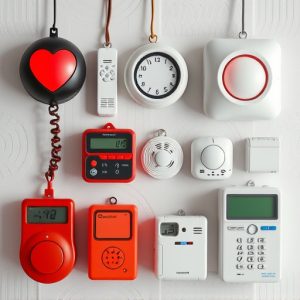Personal Safety Siren: Unlocking Benefits with Strategic False Alarm Features
Personal Safety Sirens are powerful tools designed to protect individuals during emergencies by dete…….
Personal Safety Sirens are powerful tools designed to protect individuals during emergencies by deterring threats and alerting neighbors or emergency services via high-decibel sounds. Advances in smart sensors and motion detectors have significantly reduced false alarms, ensuring these systems only respond to specific triggers. These sirens, available as portable devices or installations, cater to diverse users from students to the elderly, enhancing security and peace of mind while minimizing neighborhood disturbances through intelligent false alarm mechanisms.
Electronic personal safety alert systems, such as the powerful personal safety siren, are transforming individual protection. This comprehensive guide explores these innovative devices, their key components, and how they function to ensure your safety. We delve into the benefits of integrated false alarm features, common use cases spanning travel to remote areas to daily urban commutes, and ideal target audiences. Furthermore, we provide best practices for effective implementation, ensuring peace of mind in an uncertain world.
- Understanding Electronic Personal Safety Alert Systems
- Components and Functionality of a Personal Safety Siren
- Benefits of Using False Alarm Features
- Common Use Cases and Target Audiences
- Best Practices for Effective Personal Safety Alert Systems
Understanding Electronic Personal Safety Alert Systems
Electronic personal safety alert systems, often equipped with powerful sirens, are designed to protect individuals in emergencies. These devices serve as a crucial tool for personal safety, emitting loud and piercing sounds to deter potential threats and draw attention. When activated, the high-decibel siren alerts neighbors, bystanders, or even emergency services, signaling that someone may be in danger.
One common concern with these systems is the risk of false alarms, where the siren is inadvertently triggered without an actual threat. However, advanced technologies are now being incorporated to minimize false alarm incidents. Smart sensors and motion detectors ensure the system responds only to specific movements or unusual activities, reducing unnecessary alerts. This advancement not only preserves the effectiveness of personal safety sirens but also prevents disturbances in neighborhoods.
Components and Functionality of a Personal Safety Siren
Personal Safety Sirens are designed to provide a swift and effective means of drawing attention in emergency situations, acting as a powerful tool for personal safety. These devices typically consist of several key components: a sound source (often a high-decibel siren), an activation mechanism (such as a button or automatic sensors), a power source (usually batteries), and a housing to protect the internal mechanisms. When activated, the siren emits a loud, distinct alarm sound that can be heard over long distances, signaling distress or danger.
The functionality of a personal safety siren is straightforward yet potent. The user can trigger the alarm either manually by pressing a button or automatically through motion sensors or other triggers designed to detect potential threats. A false alarm is intentionally avoided through careful design and sensitivity adjustments to ensure the siren responds only to genuine emergencies, minimizing unnecessary disturbances while maintaining maximum effectiveness in critical moments.
Benefits of Using False Alarm Features
Implementing false alarm features in electronic personal safety alert systems offers a multitude of benefits, enhancing overall security and peace of mind for users. One of the primary advantages is the reduction of unnecessary alerts, which can help prevent anxiety and ensure that genuine emergencies are given the appropriate attention. A well-designed false alarm system learns from previous triggers, distinguishing legitimate threats from environmental noises or accidental activations.
Additionally, these features provide a layer of protection against false reports, ensuring emergency services aren’t needlessly dispatched. The personal safety siren, in particular, serves as a powerful deterrent and can quickly draw attention to a potential issue without the need for excessive activation. This ensures that resources are conserved for genuine crises while maintaining a high level of personal security.
Common Use Cases and Target Audiences
Personal safety siren systems are versatile tools with a wide range of applications, primarily aimed at enhancing individual security and peace of mind. Common use cases include personal protection for individuals who live or travel alone, especially in areas with high crime rates. These sirens can be easily carried or installed in homes, vehicles, or on key chains, allowing users to quickly attract attention and deter potential threats.
The target audiences for electronic personal safety alert systems are diverse. They cater to the needs of students living away from home, providing them with a sense of security during their commute or in isolated areas of campuses. Additionally, they are valuable for women who often find themselves walking alone at night, offering a means of self-defense and an emergency notification system. Even pet owners can benefit from these devices, using them as a deterrent against potential predators or to locate lost pets with GPS tracking features. Moreover, the elderly can use personal safety sirens to signal for help in emergencies, ensuring swift response times through automatic alerts to emergency services.
Best Practices for Effective Personal Safety Alert Systems
Personal Safety Siren systems are designed to alert users and bystanders in case of emergencies, but their effectiveness depends on several best practices. To ensure these systems serve their purpose, it’s crucial to implement clear and consistent activation triggers. This means establishing well-defined protocols for when and how the siren should be set off, whether it’s due to a personal safety threat or a false alarm. Regular maintenance and testing are equally vital; faulty equipment can fail during critical moments, so routine checks and calibration ensure optimal performance.
Additionally, education plays a significant role in the successful deployment of Personal Safety Sirens. Users should be well-versed in both the system’s functionality and appropriate response procedures. Training sessions or informational materials can help individuals recognize genuine emergencies and differentiate them from false alarms, reducing unnecessary distress while ensuring timely responses to actual threats.
Electronic personal safety alert systems, equipped with features like the personal safety siren and intelligent false alarm mechanisms, offer enhanced security for individuals across various scenarios. By understanding their components, leveraging best practices, and tailoring them to specific use cases, these systems can effectively deter threats and provide peace of mind. The benefits extend to broader communities, fostering safer environments for all. Whether for personal protection or in specialized settings, integrating these technologies is a proactive step towards navigating potential risks with enhanced vigilance.


